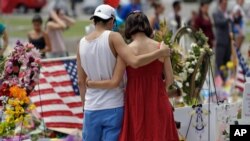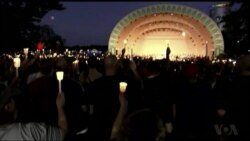Every two or three months there seems to be a mass killing somewhere. If it seems that these incidents are now more frequent, it’s because they are.
A mass shooting, where at least three or four people are killed, happens about every 64 days in the U.S.
The Federal Bureau of Investigation and several prominent U.S. universities are collecting data on these crimes, including Harvard and Stanford, as are a number of forensic psychologists, such as J. Reid Meloy, a clinical professor of psychiatry at the University of California, San Diego, School of Medicine, and a faculty member of the San Diego Psychoanalytic Center.
In a Skype interview with VOA, Meloy said things are evolving rapidly in the area of mass murder, regardless of weapon, and many of the cases involve lone actors.
Watch: Mass Killers Have Much In Common
That’s true in the mass killing January 31 in Quebec, when a 27-year-old man killed five worshipers at a mosque. It was also the case in Nice last Bastille Day (July 14) when a man driving a truck slammed into a crowd killing dozens of people, including children. In Orlando, Florida, last year, it was a lone gunman who opened fire at a nightclub killing 49 people. And the list goes on.
Studies by the FBI, the Harvard School of Public Health, Stanford University and others show mass killings have tripled in the past few years. In the U.S., semi-automatic rifles are the preferred weapons.
Common traits
Meloy told VOA that “these individuals typically have more in common than they do in terms of differences.” He said mass killers often have a history of psychiatric problems. They have rocky intimate relationships. And the killings are a quest for status.
In the Orlando nightclub shooting, Meloy said, the killer “attempted to burnish his reputation and perhaps inflate his notoriety by pledging allegiance during the mass murder itself, to two ideologically opposed groups. ... He pledged allegiance to a Sunni group as well as to Hezbollah, which is Shia. And they, of course, have been at war for 1,300 years.”
Meloy said even if the killers claim to act on behalf of a particular cause, that’s not necessarily the reason for their actions.
“For individuals who carry out mass murders, oftentimes the pathway to violence begins with a personal grievance. It typically has three components to it. One is there’s some kind of loss; secondly, there’s the feeling of humiliation; then thirdly, there’s anger toward and blaming of a person or a group of people who have caused them to have this problem.”
Personal grievance
Meloy said terrorists will often cloak their personal grievances in an ideology and will then be morally outraged by the group that they identify with.
For example, Meloy pointed out that when a U.S. Army psychiatrist opened fire at Fort Hood in Texas in 2009, the shooter closely identified with the Taliban and adopted the ideology of an Islamic radical. Meloy said the shooter’s personal grievance was the fact that he did not want to be deployed to either Iraq or Afghanistan.
Meloy said the increased use of social media is another important factor because it enables the killer to gain a level of notoriety instantaneously worldwide.
Social media also causes copycat atrocities. Meloy explained that some people become excited by seeing violence, especially if they can see it live. And that, he said, is a bad omen, because not only are people who experience violence more likely to commit it, access to social media is likely to increase the number of mass killings throughout the world.










